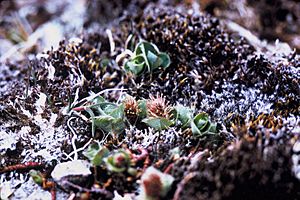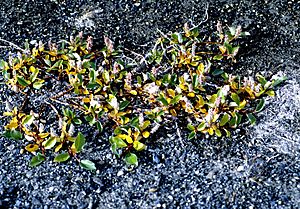Arctic willow facts for kids
Quick facts for kids Arctic willow |
|
|---|---|
 |
|
| Arctic willow foliage and male catkins | |
| Scientific classification | |
| Genus: |
Salix
|
| Species: |
arctica
|
| Synonyms | |
|
|
The Arctic willow (scientific name: Salix arctica) is a super tiny willow plant. It belongs to the Salicaceae family. This amazing plant is built to survive in the very cold Arctic regions. You can find it growing in places like the tundra, where it's often windy and frozen.
Contents
Where the Arctic Willow Lives
The Arctic willow loves cold places. It grows in the tundra and on rocky moorland. This plant is the northernmost woody plant in the world! It grows far above the tree line, even reaching the northern edge of land in Greenland.
You can also find it further south in North America. It lives in high alpine tundra areas. This includes places like the Sierra Nevada mountains in California. It also grows in the Rocky Mountains all the way down to New Mexico. In Asia, it can be found in Xinjiang, China.
What the Arctic Willow Looks Like
The Arctic willow is usually a very short shrub. It often grows to only about 15 centimeters (6 inches) tall. Sometimes, it might reach 25 cm (10 inches). But in the Pacific Northwest, it can grow a bit taller, up to 50 cm (20 inches).
Its leaves are round and shiny green. They are usually 1 to 4 cm (0.4 to 1.6 inches) long. The leaves also have long, silky, silvery hairs.
Like other willows, the Arctic willow is dioecious. This means it has separate male and female plants.
- Female plants have red-colored catkins (flower clusters).
- Male plants have yellow-colored catkins.
Even though it's small, this plant lives a very long time! It grows super slowly because of the harsh Arctic climate. One Arctic willow found in eastern Greenland was an incredible 236 years old!
Sometimes, the Arctic willow can mix with other willow types. It can create hybrids with Salix arcticola and Salix glauca.
Arctic Willow and Animals
The Arctic willow is a very important food source for many Arctic animals.
- Muskoxen eat its bark and twigs.
- Caribou also munch on its bark and twigs.
- Arctic hares and lemmings enjoy eating it too.
- The buds of the Arctic willow are the main food for the rock ptarmigan bird.
It is also the main host plant and food source for a special insect. This insect is the Arctic woolly bear moth, also known as Gynaephora groenlandica.
How People Use the Arctic Willow
Both the Inuit people and the Gwich’in people use the Arctic willow.
- They use its twigs for fuel to make fires.
- The decayed flowers, called suputiit, are mixed with moss. This mix is used as a wick in a traditional lamp called a kudlik.
The plant was also used for many different medicines.
- It helped with toothaches.
- It could help stop bleeding.
- It was used to cure diarrhoea and indigestion.
- People also made a poultice from it to put on wounds.
Both the Gwich’in and Inuit people in the Bathurst Inlet area would eat parts of the Arctic willow. It is very high in vitamin C and tastes sweet!
See also
 In Spanish: Salix arctica para niños
In Spanish: Salix arctica para niños


